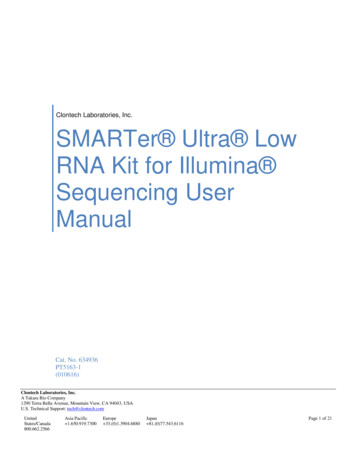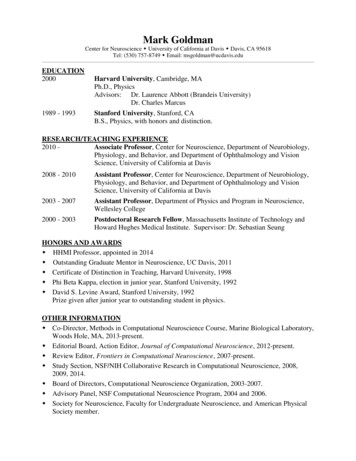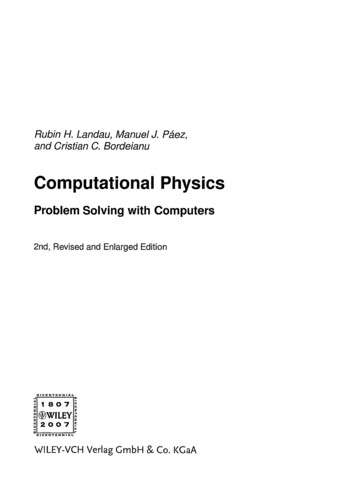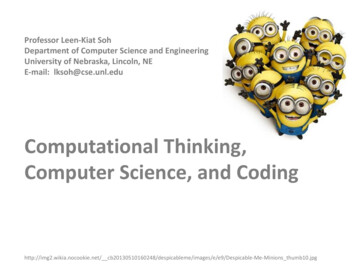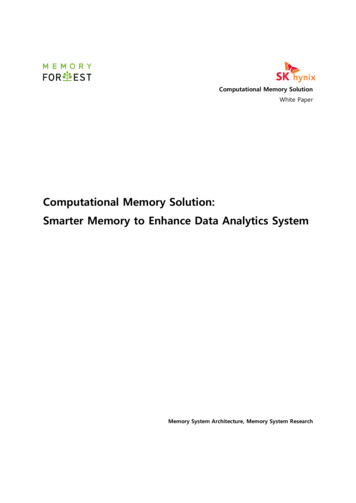
Transcription
Computational Memory SolutionWhite PaperComputational Memory Solution:Smarter Memory to Enhance Data Analytics SystemMemory System Architecture, Memory System Research
Table of ContentsIntroductionPart1: Near Data Processing Opportunities in Data AnalyticsPart2: Computational Memory SolutionPart3: Use Case Study 1: In-memory DatabasePart4: Use Case Study 2: Apache Spark SystemPart5: Future Works2
IntroductionAs the scale of data reaches the order of zettabytes and the demand for instant businessinsight surges, companies invest aggressively in enhancing their data analytics systems toprocess a massive volume of data at low latency. Such data-intensive workloads putsubstantial pressure on the underlying analytics systems, requiring unprecedentedly highbandwidth and high-capacity memory.However, conventional data infrastructures based on processor-centric architectures areinefficient to address such demands. Specifically, processor-centric architectures lackmemory scalability and cannot provide sufficient memory bandwidth and capacity required forhigher performance. Such limited memory scalability incurs significant costs to build a highperformance cluster because more servers with high-end CPUs are needed to provide therequired bandwidth and capacity. Furthermore, current data warehouse and analytics systemsconsume substantial energy to transfer enormous data between memory and processors.Such significant data traffic has become a performance bottleneck in today's datainfrastructures.Computational Memory Solution (CMS) has been designed to overcome all the abovedrawbacks related to conventional data infrastructures and to address the demands for highbandwidth and high-capacity memory. In contrast to the traditional processor-centric approach,CMS is a data-centric computing solution based on Near-data Processing that leveragesexceptionally high internal bandwidth and capacity to accelerate memory-intensive workloads.CMS also saves power by reducing data traffic between memory and processors.Ultimately, CMS 1) delivers high-performance for various memory-intensive workloads, 2)provides cost-effective scalability in system performance and memory capacity, and 3)reduces the total cost of ownership (TCO) for modern data analytics systems.CXL / PCIeScalabilityHigh PerformanceReduced TCOFigure 1 CMS delivers high performance, scalability, and reduced TCO3
Part1: Near Data Processing Opportunities in Data AnalyticsNear-data Processing (NDP) refers to processing data in proximity to the memory where datais stored. Due to its proximity to memory, NDP can efficiently accelerate data-intensiveworkloads by leveraging extremely high bandwidth to memory. In particular, NDP is mosteffective for workloads requiring relatively simple yet parallelizable computation thatprocesses massive data.Why Data Analytics?Many existing data analysis applications are data-intensive, requiring high memory bandwidthand capacity. However, current compute-centric systems running these applications areinefficient in handling such workloads because their architectures are optimized for computeintensive workloads, whose characteristics are fundamentally different from memory-intensiveones. The mismatch between characteristics of memory-intensive data analytics applicationsand attributes of compute-centric systems causes considerable inefficiencies and costs inbuilding high-performance data analytics systems.Figure 2 Roofline analysis for representative data analysis operations: project, filter, aggregate, join,window, and k-NN. The X-axis is Operational Intensity (OI), and the y-axis is the anticipatedperformance in GFLOPs. The figure indicates that CMS offers 5.3 times higher aggregate memorybandwidth than an Intel Xeon Gold6246 server, and therefore, can deliver up to 5.3 times performanceimprovement for all the operations.Typical data analysis queries involve simple yet highly parallelizable operations dealing withlarge datasets, such as project, filter, aggregate, or join. These operations feature low4
Operational Intensity (OI), an ideal characteristic for Near-data Processing. Figure 2 presentsthe result of the Roofline analysis1 for representative SQL operations (project, filter, aggregate,join and window) and a machine learning function (k-NN). All of them, including many otherSQL operations, are memory-bound with OIs significantly lower than the ridge point of modernCPUs. Therefore, providing high memory bandwidth is crucial to enhance their performance.Indeed, our experiments with SQL queries provided evidence that numerous SQL queries arememory-bound when filtering, aggregating, or joining large datasets. As presented in Figure3, we measured the memory bandwidth utilization for TPC-DS queries running on our dataanalytics cluster. We observed that the system's memory bandwidth utilization was often atthe maximum when CPUs were busy processing queries.Figure 3 Memory bandwidth hits the maximum when running SQL queries. In this experiment, we ranTPC-DS Q26 on an Intel Silver 4114 server with peak memory bandwidth of 76.8GB/s, whosesustainable memory bandwidth measured by Stream Benchmark is 39 45 GB/s. Only 50% of the totalCPU cores were used to run the query.Furthermore, we experimented with a k-NN algorithm to see how much we could acceleratethe algorithm using compute resources available for an x86 server. As shown in Figure 4, kNN performance immediately flattened as the number of threads increases. Due to the low OIof k-NN, its performance is bounded by the memory bandwidth once the number of threadshas reached 7, which corresponds to mere 25% utilization of the total compute resources.Unfortunately, increasing memory bandwidth usually involves upgrading to high-end serversor introducing more servers to the analytics cluster, incurring high costs. In fact, low-OIs andhigh-bandwidth requirements of typical data analysis workloads suggest the need for a newsolution that scales memory bandwidth more efficiently.1Williams, S., Waterman, A.; Patterson, D. (2009). Roofline: An insightful visual performance model forfloating-point programs and Multicore Architectures.5
k-NN Performance3500Execution 30# of threadsFigure 4 k-NN is memory-bound, and using more than 25% of the total compute resources does nothelp improve its performance. This experiment involves processing a batch of 128 k-NN queries, eachof which calculates and compares distances to 100,000 256-dimension samples and selects the knearest ones. Xeon E5-2690 v4 is used for this experiment.Given the above results, a plausible solution is to introduce CMS to the analytics system. Inthe following sections, we introduce CMS and analyze its benefits for high-performance dataanalytics system.6
Part2: Computational Memory SolutionComputational Memory Solution (CMS) offers a scalable card-type memory composed of anNDP core and large capacity memory, as shown in Figure 5. CMS provides high-performancefor memory-intensive workloads by Near-data Processing that leverages ultra-high internalmemory bandwidth. It also offers cost-effective scalability in performance and capacity.Specifically, CMS allows customers to scale their systems by simply inserting additional CMScards into their servers via PCIe or Compute Express Link (CXL). Since customers canaugment their analytics cluster using additional CMS cards with fewer servers, yet experienceequivalent performance, they can significantly reduce the total ownership cost. In particular,we expect our CMS solution integrated via Compute Express Link (CXL) will deliverunprecedented performance and memory scalability for large-scale data analytics systems.Figure 5 Computational Memory SolutionReference System for Experiment and AnalysisAlthough CMS can enhance any system that runs memory-intensive workloads, this paperexamines the benefits of CMS for a real-time data analytics system comprising an in-memorydatabase and Apache Spark. As presented in Figure 6, the reference system used for ourexperiment consists of LightningDB2 as a storage engine and Apache Spark as a computeengine.2Lightning DB - DRAM/SSD optimized Real-time In-memory DBMS (https://lightningdb.io/)7
Figure 6 Reference real-time analytics systemWe uploaded the input datasets into the reference in-memory database (LightningDB) beforequerying the data for all our experiments. In later sections, we use the measurements collectedfrom this reference system to project the performance improvement CMS can deliver to inmemory databases and Apache Spark, respectively.CMS-augmented In-memory DatabaseIn-memory databases offer minimal response time by fetching data directly from memory. Wechose LightningDB as our reference in-memory database because it also supports pushdownfiltering and aggregation to reduce the data traffic to the upper compute engine. As Figure 7presents, CMS augments the reference in-memory database cluster with CMS cards that canaccommodate much more data and accelerate pushdown filtering and aggregation.Figure 7 Reference in-memory database integrated with CMS cards8
CMS-augmented Apache Spark SystemApache Spark is a distributed computing engine that processes big data sets using theMapReduce programming model. Similar to the case for in-memory databases, CMSaugments the Apache Spark cluster with CMS cards that can store significantly larger datasetsand accelerate SQL queries. Enlarged memory capacity also enables keeping frequentlyaccessed datasets in memory through Spark's caching feature, further enhancing the queryresponse time.Figure 8 Reference Apache Spark system integrated with CMS cards9
Part3: Use Case Study 1: In-memory DatabaseAmid rapidly increasing demands for real-time analytics, many applications employ in-memorydatabases to attain minimal response time by fetching data directly from memory rather thanfrom disks or SSDs. On top of their fast response time, many latest in-memory databasesfeature pushdown filtering or aggregation as performance optimization by allowing the dataanalytics compute engine, such as Apache Spark, to push filtering or aggregation operationsdown to the underlying in-memory database. Such pushdown optimization coupled with shortresponse time enhances the entire data analytics system by significantly reducing the amountof data transferred to the compute engine at extremely low latency.Albeit their significant advantages for data analytics at scale, in-memory databases have toovercome several limitations to be adopted more widely. First of all, in-memory databasesrequire substantial memory capacity to prevent disk-spill from degrading the response time.Since memory is much more expensive than disks or SSDs, storage-based databases areoften preferred over in-memory databases when accommodating a large volume of data.Furthermore, handling pushdown filtering or aggregation operations requires non-negligiblecompute resources already occupied with managing other database requests.CMS addresses these problems by offering scalability both in capacity and performance.According to our analysis, as more CMS cards are integrated into our reference in-memorydatabase, the predicate pushdown performance of the system increases almost linearly whilethe memory capacity scales in proportion to the number of cards. For instance, an in-memorydatabase server integrated with four CMS cards offers four times larger memory capacity anda similar increase in the predicate pushdown performance for the NYC Taxi Benchmarkqueries without requiring additional CPU resources. This result suggests that CMS couldenable customers to build a high-performance in-memory database cluster with significantlyfewer servers, thereby substantially reducing the total ownership cost.Query Execution Time (sec)1086420Q1ReferenceQ21 CMS cardsQ32 CMS cardsQ44 CMS cardsFigure 9 NYC Taxi Benchmark query execution time. Reference in-memory database comprises fourIntel Xeon Gold 6140 servers with 170GB/s memory bandwidth for each. The original NYC Taxi datasethas been scaled down to fit in the cluster. CMS has been applied only to the in-memory database for10
this analysis. The filter and aggregation pushed down to the in-memory database are accelerated byNDP cores, which filter and aggregate the data stored in their nearby memory.Part4: Use Case Study 2: Apache Spark SystemApache Spark has become the most prevalent compute engine for large-scale data processing.The vast majority of data analytics companies are using Apache Spark in production toprocess an enormous number of data analysis queries to extract business insights. As datavolume increases exponentially, the number of servers to form a Spark cluster also grows,resulting in significant overheads associated with managing numerous Spark tasks, such astask scheduling and shuffle IOs. In addition, the common practices of using small partitionsizes and a large number of Spark tasks to maximize the CPU utilization are amplifying theseoverheads, making linear performance scaling of analytics systems challenging to achieve.CMS enables customers to build a cluster with considerably fewer and more affordable serversthat run potentially smaller numbers of tasks. Specifically, near-data processors of CMSaccelerate memory-intensive SQL operations by leveraging its ultra-high internal memorybandwidth. In addition, a high aggregate memory capacity of multiple CMS cards allows usinglarger partition sizes, thereby fewer Spark tasks. This helps reduce task scheduling and shuffleIO overheads. Overall, acceleration of SQL operations via Near-data Processing combinedwith reduced scheduling and shuffle IO overheads leads to greater performance at a reducedtotal cost of ownership.According to our analysis, TPC-DS query performance improves as we integrate more CMScards into Spark servers of our reference data analytics system and configure Spark tasks toprocess larger data partitions. For instance, Q26 performance improves by 2.3x with a CMScard and 5.4x with 4 CMS cards. For the select TPC-DS queries presented in Figure 10, ouranalysis predicts CMS could improve their response time up to 7x.Query Execution Time (sec)9876543210Q26ReferenceQ96Q421 CMS cardQ32 CMS cardsQ32Q764 CMS cardsQ708 CMS cards11
Figure 10 TPC-DS benchmark query execution time. TPC-DS dataset size has been chosen to fit in ourreference in-memory database cluster. CMS has been applied only to the Spark cluster for this analysis.The in-memory database only provides the input data to the Spark cluster without pushdown filter oraggregate enabled. The Spark cluster comprises an Intel Silver 4114 server with 76.8GB/s memorybandwidth.We also conducted an analysis that compares the performance of a multi-node CPU-onlycluster with that of a single-node cluster augmented with CMS cards. Based on our analysis,a single-node cluster equipped with 2 CMS cards provides comparable performance to thefour-node CPU-only cluster for the select queries we analyzed. This result implies that CMScould reduce the total cost of ownership for the Apache Spark cluster by decreasing therequired number of servers to achieve target performance.All the above analyses assume that input datasets have been loaded into the in-memorydatabase of our reference data analytics system. In addition, the analysis is based on scaledup partition size per task as more CMS cards are integrated into the Apache Spark cluster toreduce task scheduling and shuffle IO overheads.Performance Comparison300Execution Time25020015010050001234Number of CMS cardssingle-node CMS card(s)four-node CPU-onlyFigure 11 CMS reduces ownership costs by requiring fewer servers to form a Spark cluster. A singlenode Spark cluster comprising an Intel Silver 4114 server (76.8GB/s memory BW) and two CMS cardsshows comparable performance to a multi-node CPU-only cluster consisting of four Intel Xeon Gold6140 servers (170GB/s memory bandwidth for each). The execution times for TPC-DS Q26 are usedfor this analysis.12
Part5: Future WorksBy using analytical performance modeling and measured results from our reference system,our analyses have demonstrated that CMS could be a cost-effective, high-performancesolution that can enhance various modern big data applications. CMS is a technologicalbreakthrough that could improve the performance of memory-intensive workloads, achievecost-effective scalability in performance and memory capacity, and reduce ownership costsfor data analytics systems.Currently, a prototype for Computational Memory Solution targeting data analytics is beingdeveloped, and the solution is expected to be available to the market shortly.13
New Initiatives (Memory Forest)As the demand for big data and AI increases, data is growing explosively in both volume andvariety. Such has led to the emergence of data-centric workloads that manipulate and analyzemassive amounts of data. Consequently, the burden of data processing and energyconsumption from data movement is becoming a critical issue for this rapidly growing segment.For the latest AI models (e.g. Google AI switch, Open AI GPT3) that require large-scaleparameters, the energy cost of data movement is substantially higher than that of computation.In some popular Google applications, 62.7% of the total system energy is spent on datamovement between CPU and main memory. This energy consumption due to data movementis expected to widen as the era of AI-based big data processing accelerates, rendering itessential to reduce data movement in order to improve performance and energy efficiency indata-centric computing systems.The shift from a compute-centric to a data-driven era is an opportunity for SK hynix to take ona central role in the new ICT (Information & Communications Technology) industry. Havingdefined a more granular hierarchy for memory in each data processing stage, we are workingto make servers and other systems more efficient with targeted solutions such as HighBandwidth Memory (HBM), the multiprocessor-compatible Compute Express Link (CXL)interface, Processor-in-Memory (PIM) and Computational Memory Solution (CMS). MemoryForest shown in Figure 1 is our new initiative and slogan that encapsulates our strategy tobuild a memory-driven ecosystem with such technical expertise. Just like the lush, green forestit represents, the initiative will generate value from new memory systems and technologies tonurture a wider global ecosystem that produces ESG values for our customers and partners‒ essentially with Memory for the Environment (E), Society (S), and Tomorrow (T). This paperdescribes the CMS, one of SK hynix Memory Forest initiatives.Figure 12 SK hynix Memory Forest Initiatives14
Many researchers consider a departure from traditional CPU-centric computing systems, akaVon Neumann architecture, which involves complete separation of the computing and memoryunits. The work in adds extra computing units close to the memory to process the data locally.Processing in memory (PIM) is one of the solution that addresses the data movement issueby processing certain tasks inside memory blocks, resulting in improvements for bothperformance and energy efficiency. However, for some data-intensive workloads, a solutionthat can reduce inter-node communication by providing sufficient memory capacity andbandwidth to the processing unit is more suitable. In this research, we studied the architectureand use cases for the solution and implemented an FPGA PoC.Legal disclaimerThe information contained in this document is claimed as property of SK hynix. It is provided with theunderstanding that SK hynix assumes no liability, and the contents are provided under strictconfidentiality. This document is for general guidance on matters of interest only. Accordingly, theinformation herein should not be used as a substitute for consultation or any other professional adviceand services. SK hynix may have copyrights and intellectual property right. The furnishing of documentand information disclosure should be strictly prohibited. SK hynix has right to make changes to dates,product descriptions, figures, and plans referenced in this document at any time. Therefore theinformation herein is subject to change without notice.About SK hynix Inc.SK hynix seeks to propel the semiconductor industry forward with global tech leadership, and providea future of greater value to stakeholders to create a better world with information and communicationtechnology. As the world’s third largest chipmaker with know-how and customer trust built over morethan 38 years, SK hynix continues delivering on a comprehensive range of memory semiconductorsolutions from DRAM and NAND Flash to CMOS image sensors.The company’s advanced memory technologies are driving critical innovations of the Fourth IndustrialRevolution such as Big data, AI, Machine Learning, IoT, and Robotics. Moreover, SK hynix is aiminghigher with the new “Memory Forest” initiative to quickly respond to future changes in the ICT ecosystem.With robust ESG management that accounts for value to the environment, societies, and futuregenerations, SK hynix will continue to build competence and success around the globe. 2021 SK hynix Inc. All rights reserved. Specifications and designs are subject to change withoutnotice. All data were deemed correct at time of creation. SK hynix is not liable for errors or omissions.W-CMS-E01-211029-R0215
Apache Spark is a distributed computing engine that processes big data sets using the MapReduce programming model. Similar to the case for in-memory databases, CMS augments the Apache Spark cluster with CMS cards that can store significantly larger datasets and accelerate SQL queries.



